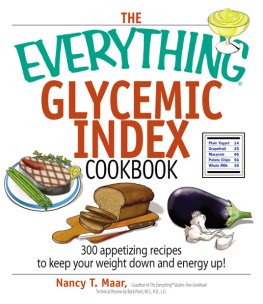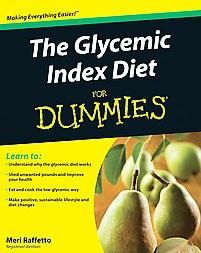Contents
Guide
The Glycemic Load Counter
Dr. Mabel Blades
A Pocket Guide to GL and GI Values for over 800 Foods
Text copyright 2008, 2021 Dr. Mabel Blades. Design copyright 2008, 2021 Ulysses Press. All rights reserved. Any unauthorized duplication in whole or in part or dissemination of this edition by any means (including but not limited to photocopying, electronic devices, digital versions, and the internet) will be prosecuted to the fullest extent of the law.
Published in the US by:
ULYSSES PRESS
P.O. Box 3440
Berkeley, CA 94703
www.ulyssespress.com
First published as The GI Counter in Great Britain in 2007 by Kyle Cathie Limited
ISBN: 978-1-64604-249-4
ISBN: 978-1-64604-287-6 (ebook)
Library of Congress Control Number: 2021937810
US proofreader: Joyce Wu
Production: Yesenia Garcia
Front cover design: Brenda Abbott
NOTE TO READERS: This book has been written and published strictly for informational and educational purposes only. It is not intended to serve as medical advice or to be any form of medical treatment. You should always consult your physician before altering or changing any aspect of your medical treatment and/or undertaking a diet regimen, including the GL guidelines as described in this book. Do not stop or change any prescription medications without the guidance and advice of your physician. Any use of the information in this book is made on the readers good judgment after consulting with his or her physician and is the readers sole responsibility. This book is not intended to diagnose or treat any medical condition and is not a substitute for a physician.
INTRODUCTION
The Glycemic Index and Glycemic Load are values given to different carbohydrate foods based on how they impact blood sugar levels. The GL is a development of the Glycemic Index that takes into account the amount of carbohydrates in a food and the bodys response to them.
There are many reasons why you might want to keep an eye on your GL intake, and this counter was developed to help you choose foods wisely rather than having to look at lots of other lists, websites, and packages. And because carbohydrate content or GL should not be considered in isolation, I have also provided information on calorie content and fat levels.
So What Exactly Is Gl?
The Glycemic Index measures the way in which we break down carbohydrate foods into the simple sugar glucose, which is then absorbed and used in our bodies for energy. Like the GI, the Glycemic Load is an index that ranks foods according to their effect on blood sugar. The difference, however, is that GI gives us information on how quickly blood sugar rises after we eat 50g (about 2oz) of digestible carbohydrates in various foodswhich is nearly impossible to do in some cases. Youd have to eat two pounds of watermelon to get 50g of digestible carbohydrates out of it! The GL, on the other hand, reflects the change in blood sugar caused by eating a normal portion of food. Its a more accurate assessment of foods because it reflects the amount of carbohydrates you actually eat. Watermelon, as mentioned before, is a great example of this. It has a high GI (about 70) because the carbohydrate it contains is glucose, which is pure sugar. But because watermelon contains very little glucose overall, it has a low GL of just 5 for a normal-sized serving. You would have to eat ten times a normal portion of watermelon to get the same rise in blood sugar as you would from eating a normal serving of white bread (which, under the confusing Glycemic Index system has an almost identical GI as watermelon). So whereas GI would have you think that watermelon is bad for you, GL proves that its actually great!
Why Is a Low-Gl Diet Good for You?
Foods with a low GL sustain our blood sugar levels, or rather blood glucose levels, for longer than those with a high GL, which cause a peak in blood sugar levels followed by a slump. When our blood sugars are maintained at a moderate level, we tend not to feel hungry. When the level zooms up after eating a high GL food, the dramatic dip that follows takes blood sugars down to a level at which we can feel really hungry. It must be emphasized that the GL is concerned solely with carbohydrates, so proteins and fats all have zero GL because they are not made up of glucose units. This fact has led to some controversy about the value of a low-GL diet. But in my experience, most people who are trying to lose weight, or are keeping an eye on their diet for specific health reasons, are sensible enough to know that fats are high in calories and that too many lead to weight gain!
What Are the Ranges for GL?
- Low-GL foods are those with a value of 10 and below.
- Medium-GL foods are those foods with a value of 1119.
- High-GL foods are those with a value of 20+.
GL and Weight Loss
The value of the GL is to help you make more prudent choices regarding foods. In general, a woman wanting to lose weight on 1500 calories per day should eat about 200g of carbohydrates, and a man trying to lose weight on 2000 calories per day, about 260g. At least half of this should have a low GL (10 and below). This will result in a slow but steady weight loss of about one to two pounds per week.
The main point is to try and keep mostly to low-GL carbohydrate foods. That means eating lots of fresh foods like fruits and vegetables, which we all know are the basis of a healthy diet. It is also sensible to combine carbohydrate foods with a protein food such as fish, eggs, or cheese, or vegetable sources of protein like nuts. For flavor and ease in cooking, perhaps add a little healthy fat like olive oil or canola oil. Foods such as meat, fish, cheese, and eggs all have a GL of zero, but they do contain different amounts of fat and provide a source of calories. So it is important to take a common sense approach and not to base the diet on these foods alone.
Although many people are obsessed with their weight and trying to lose it, they really should be trying to lose body fat while preserving muscle tissue. This means exercise has to be included in their daily patterns.
This type of low-GL diet makes a sensible, balanced eating program, which will keep you feeling full and energetic, while providing all the healthy nutrients your body needs.
Conditions Helped by a Low-GL Diet
A diet with a low GL is considered to be helpful for a number of conditions, including:
- Managing weight loss and preventing weight gain by promoting a feeling of fullness and avoiding very low blood sugar levels, which send you running for a snack.
- Diabetes, because it helps stabilize blood sugar levels.
- Raised cholesterol levels, because the soluble fibers found in such low-GL foods such as oats, fruits, and vegetables reduce the absorption of saturated fat and cholesterol.
- Polycystic ovary syndrome (PCOS), from which increasing numbers of women (some say as many as 10%15%) suffer and for which maintenance of blood sugar is important. Symptoms of PCOS include irregular or absent periods, very greasy skin, facial hair growth, hair loss, mood swings, and difficulty with excessive weight gain.
- Metabolic syndrome (sometimes referred to as syndrome X), which is the precondition for Type 2 diabetes and coronary heart disease. It is characterized by weight gain (especially around the middle area, creating the so-called apple shape), raised blood pressure, high blood sugar, and high cholesterol levels, as well as raised triglyceride levels.









